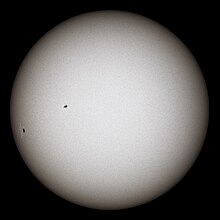
Luminosity is an absolute measure of radiated electromagnetic energy per unit time, and is synonymous with the radiant power emitted by a light-emitting object.[1][2] In astronomy, luminosity is the total amount of electromagnetic energy emitted per unit of time by a star, galaxy, or other astronomical objects.[3][4]
In SI units, luminosity is measured in joules per second, or watts. In astronomy, values for luminosity are often given in the terms of the luminosity of the Sun, L⊙. Luminosity can also be given in terms of the astronomical magnitude system: the absolute bolometric magnitude (Mbol) of an object is a logarithmic measure of its total energy emission rate, while absolute magnitude is a logarithmic measure of the luminosity within some specific wavelength range or filter band.
In contrast, the term brightness in astronomy is generally used to refer to an object's apparent brightness: that is, how bright an object appears to an observer. Apparent brightness depends on both the luminosity of the object and the distance between the object and observer, and also on any absorption of light along the path from object to observer. Apparent magnitude is a logarithmic measure of apparent brightness. The distance determined by luminosity measures can be somewhat ambiguous, and is thus sometimes called the luminosity distance.
- ^ "Luminosity | astronomy". Encyclopedia Britannica. Retrieved 24 June 2018.
- ^ "* Luminosity (Astronomy) - Definition, meaning - Online Encyclopedia". en.mimi.hu. Retrieved 24 June 2018.
- ^ Hopkins, Jeanne (1980). Glossary of Astronomy and Astrophysics (2nd ed.). The University of Chicago Press. ISBN 978-0-226-35171-1.
- ^ Morison, Ian (2013). Introduction to Astronomy and Cosmology. Wiley. p. 193. ISBN 978-1-118-68152-7.